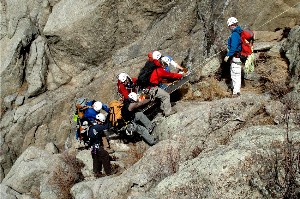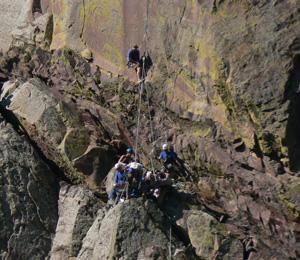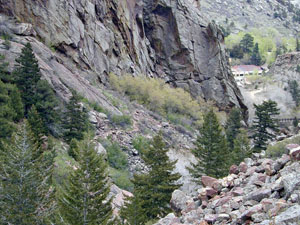






RMRG is a fully
accredited
Mountain Rescue Association (MRA) team
For rescue assistance, call 911 or Boulder County Sheriff's dispatch
(303) 441-4444

Thanks to our supporters:
|
|
Operational Frequently Asked Questions (FAQ)
This "Operational FAQ" addresses some of the
common questions and misperceptions about our rescue operations.
If you have a specific question about a technique, method or even a particular
rescue please contact us and we will
attempt to answer to the best of our ability, as time permits. See also
Rescue Operations - How does it all work? (Note that
it is our policy not to discuss specific patient medical information with the public.)
FAQ1: Why do these rescues take so long?FAQ2: Why do you carry the litter straight downhill instead of using a trail? (Or, what is a “scree evacuation?”)FAQ3: Why do these rescues require so many rescuers? And why are many of those people just standing around?FAQ4: Why do the rescuers continue to wear backpacks during the evacuation? Wouldn't it be easier without them?FAQ5: Why do you use a litter on a vertical evacuation instead of lowering someone with a climbing harness to save time?FAQ6: Why send the litter across the stream on a high line (Tyrolean traverse)? Why not just walk down the trail to the bridge?FAQ7: Why did you close the road or my favorite trail?FAQ8: Does RMRG ever look at other, possibly more efficient, rescue techniques?FAQ9: Does RMRG ever use actual rescue evacuations as training events?FAQ10: Will I get charged for rescue?FAQ11: How can I help? |
FAQ1: Why do these rescues take so long?From the time RMRG is dispatched to the time the patient is delivered to the ambulance, most mountain rescues in Boulder County are completed in less than two hours. Rescues go faster if access to the patient is uncomplicated and/or a short distance from a trailhead. Rescues requiring highly technical litter evacuations from climbing walls (such as the Redgarden Wall in Eldorado Canyon State Park) usually take significantly longer due to their complicated, multi-stage nature (see FAQ3). Establishing patient location and rescuer access, providing stabilizing medical care, getting the evacuation gear to the scene, building suitable lowering anchors, and evacuating the patient(s) all add to the total time to complete the rescue. RMRG strives to minimize the time required for rescues, which maximizes both patient and rescuer safety.Return to top |
FAQ2: Why do you carry the litter straight downhill instead of using a trail? (Or, what is a “scree evacuation?”)Evacuating an injured person over rough terrain is hard physical work. An average-sized patient, plus medical equipment and the litter itself, usually weighs around 250 lbs. Our standard is to have six litter bearers. Each rescuer then has to lift and hold around 40 lbs. Walking or moving quickly down a steep trail while trying to carry a 40 lb load is not difficult if it is well packaged in a backpack, but it can be quite difficult if it is part of a 250+ lb load that 5 other people are also carrying. Foot trails are rarely wider than a single person. A litter is carried with three rescuers on each side, so the total width of a carried litter is about six feet. Thus while carrying a litter along a typical trail crossing a hillside, the rescuers' feet are actually on the loose and much rougher terrain upslope and downslope of the trail. A litter evacuation following a trail across a hill would have a high risk of rescuers slipping or dropping the litter-borne patient. Scree evacuation litter lowering; click to enlarge
Scree evacuation litter lowering; click to enlarge
Return to top |
FAQ3: Why do these rescues require so many rescuers? (And why do many of those people appear to be just standing around?)Mountain rescue can be a complicated, multi-stage process with many distinct activities. Even when only a scree evacuation (see FAQ2) is required, the logistics of the rescue can be quite involved. Occasionally we need to use up to three different evacuations for the same rescue: a vertical evacuation, a scree evacuation, and a Tyrolean highline. Some rescuers go into the field fast and light (the "hasty team") to reach the patient quickly and begin medical care. Subsequently, multiple rescuers carry gear (e.g. litter, full-body vacuum splint, oxygen, medical kits, ropes, anchor equipment, litter rigging, brakes/belay devices, etc.) up to the scene. A vertical evacuation usually requires two litter attendants, one or two other rescuers to manage medical care and loading the patient into the litter, and personnel to build and manage an anchor. A scree evacuation usually requires a six-person litter team, route finders, brakemen, and rope handlers to implement the belays. A Tyrolean (see FAQ6) requires a haul team to tension the highline and personnel to handle tag lines to control the litter as it traverses the highline. Each distinct phase of the rescue requires one or two personnel to oversee, plan, and consider overall safety and efficiency issues. Command personnel manage contact with the rest of the world, including air ambulance service, the news media, and park visitors. Consider a climber injured mid-wall. He or she must first be secured, then medically evaluated and stabilized. A rescue-strength anchor is built for the evacuation and gear (litter, medical kits, ropes) is either lowered or raised to the patient's location. Rescue anchors commonly hold 1,000 lbs. (4.5 KN), considerably more than normal loads for recreational climbing anchors. The patient is then loaded into the litter – possibly while rescuers and/or the patient are hanging in a harness. The patient is then lowered down the cliff with two litter attendants attached to the litter. (In rare cases the litter might be hauled up, requiring further personnel for a haul team.) From the base of the cliff, the patient must be evacuated to the nearest road, or possibly to an air-ambulance (helicopter) landing zone. This often requires a scree evacuation (see FAQ2) and occasionally a Tyrolean highline (see FAQ6). Each activity takes multiple rescuers to complete efficiently and safely. Management of the overall rescue and of each component is also a critical function and requires additional personnel in the field and at the trailhead. While a vertical evacuation can often be done with 5-10 people Mid-wall loading patient into litter; click to enlarge
Mid-wall loading patient into litter; click to enlargeReturn to top |
FAQ4: Why do the rescuers continue to wear backpacks during the evacuation? Wouldn't it be easier without them?Rescuers carry a variety of personal and group gear in their backpacks during rescues, the amount and type of which varies based on the projected time and conditions under which the rescue will take place. During the evacuation, even one that is expected to be relatively short, rescuers may need water, replacement protective gloves, an extra jacket, webbing slings, carabiners, etc. If they carry their backpacks with them then they are likely to be "back in service" as soon as the evacuation is complete, rather than having to backtrack to retrieve personal gear or have other rescuers carry their personal gear down for them. Personal rescuer preparedness also expedites availability for any subsequent rescue responses during or soon after the active rescue. More importantly, however, the evacuation of an injured patient through a scree field exposes both rescuers and the patient to significant rock fall hazard from the hillside. Because the patient is strapped into the litter and unable to protect themselves, rescuers are trained to shield the patient from any falling rocks that come toward the litter. Rescuers' helmets and backpacks protect their heads, necks, and spines and are their only defense against rock fall. Rescuers will attempt to turn so that their packs are facing uphill to absorb the impact and thus protect both themselves and the patient as much as possible.Return to top |
FAQ5: Why do you use a litter on a vertical evacuation instead of lowering someone with a climbing harness to save time?The nature of the patient's injuries and the logistics of extracting them dictate how we approach "packaging" our patient. Often, injured climbers have been lowered to the ground by their partner (or other climbers) before RMRG arrives. However, if an injured climber is still mid-wall when we arrive at the accident scene, it is likely because their injuries were serious enough that they could not self-rescue. Although time is often critical in these situations, stabilizing the patient's injuries for the rough ride down the wall and to the ambulance may be one of the most critical steps for a positive outcome. For certain serious injuries, it is particularly crucial that we immobilize the patient with a full-body splint to reduce the risk of further injury or even death. In some cases, however, the best solution may be to simply lower the injured or stuck person to the ground, in which case that is the approach that will be taken. Clearly, mid-wall rescue work is dangerous for both the injured person and rescuers. We therefore always strive to minimize the dangers while doing what is in the best interests of the patient.Return to top |
FAQ6: Why send the litter across the stream on a high line (Tyrolean traverse)? Why not just walk down the trail to the bridge?In certain circumstances, using a Tyrolean traverse to cross a creek or gully is the best evacuation route. For instance, all evacuations that originate on the north side of South Boulder Creek in Eldorado Canyon (Rincon Wall, Redgarden Wall, West Ridge, Wind Tower, etc.) must somehow cross the creek. Using the foot bridge near the Whale's Tail is a preferred exit route when feasible. In certain situations, such as evacuations from the Wind Tower or Whale's Tail areas, we do use the bridge. The foot bridge is wide enough to walk across with a litter and litter team, which is similar in width to walking three people abreast. For evacuations from other areas, the footbridge route is either unfeasible, inefficient, slower, more dangerous, or all of the above. To evacuate a patient from the Redgarden Wall area west of the “Lower Ramp,” the patient must first be brought down to South Boulder Creek by scree evacuation (see FAQ2), then the creek must be crossed. To reach the foot bridge from the north side of the creek, rescuers would have to carry the litter-borne patient along the trail, traversing the hillside. This evacuation route would be difficult work for the litter bearers, rough on the patient, difficult to effectively belay, and destructive to the trail and hillside (see FAQ2). Thus our options are to carry the litter across the stream (wading), carry the litter to the bridge along the Streamside Trail, or set up a Tyrolean traverse to lift the litter across the creek with a taut cable or rope. Eldorado Canyon, Streamside Trail middle, footbridge lower right; click to enlarge
Eldorado Canyon, Streamside Trail middle, footbridge lower right; click to enlargeReturn to top |
FAQ7: Why did you close the road or my favorite trail?When the safety of the public is endangered by rescue operations we may ask park rangers to temporarily close a park area, road, or trails. Certain evacuations in Eldorado Canyon State Park, for instance, bring the litter and litter crew down steep, loose scree slopes (see FAQ2). Rock fall danger from the evacuation may pose a hazard to popular, high-traffic trails below the rescue operation. We make every effort to minimize the time that any road or trail is closed to traffic.Return to top |
FAQ8: Does RMRG ever look at other, possibly more efficient, rescue techniques?Continuously. We experiment with alternative systems on a regular basis, both during our field trainings and using our test tower. In the last several years we have evolved our litter patient-packaging system, modified our litter rigging, and made several other equipment changes. In 2006, after a couple years of testing, we replaced the kind of rope we use in our systems, which rippled through virtually all the other rescue systems and techniques we use. We also have many opportunities to see and work with systems and techniques that differ substantially from our own. In the last three years alone members of RMRG have trained with, or performed rescues with, RMRG test tower from above
RMRG test tower from above
Return to top |
FAQ9: Does RMRG ever use actual rescue evacuations as training events?No. Each year RMRG conducts 30-35 field trainings, and about 20 classroom trainings, totaling approximately 6,000 person-hours per year for training alone. In field trainings we often contrive complex problems for training purposes. As with any skilled activity, from practicing medicine to mountain guiding, training is the foundation of the mountain rescuer's skills. Competent trainees initially participate on actual rescues with close supervision by experienced rescuers. On actual incidents with real patients, rescuer safety followed by quality patient care are our highest priorities. We never delay patient evacuation or overly complicate evacuation systems during operational missions for training purposes.Return to top |
FAQ10: Will I get charged for rescue?Not by RMRG. Rocky Mountain Rescue is an all-volunteer 501(c)(3) charitable non-profit organization and does not charge for rescue. We are a member team of the Mountain Rescue Association (MRA), and we support their public position that charging for mountain rescue may delay a call for help. Medical services provided by an ambulance or air-ambulance are typically billed to the patient.Return to top |
FAQ11: How can I help?Thanks for asking! We are an all-volunteer organization and are always seeking additional motivated climbers, mountaineers, and other active and skilled outdoors people. RMRG is a 501(c)(3) charitable non-profit cooperation and we typically get about 50% of our $60,000 annual operating budget from donations and grants. Please see our Get Involved page and Fundraising page to find out how you can become a member or support us financially.Return to top |
| This page is superseded | Visit our current web site at |
http://RockyMountainRescue.org |
Rocky Mountain Rescue Group, Inc. 3720 Walnut St, Boulder, CO 80301, USA |
Copyright 2017, Rocky Mountain Rescue Group, Inc. |







